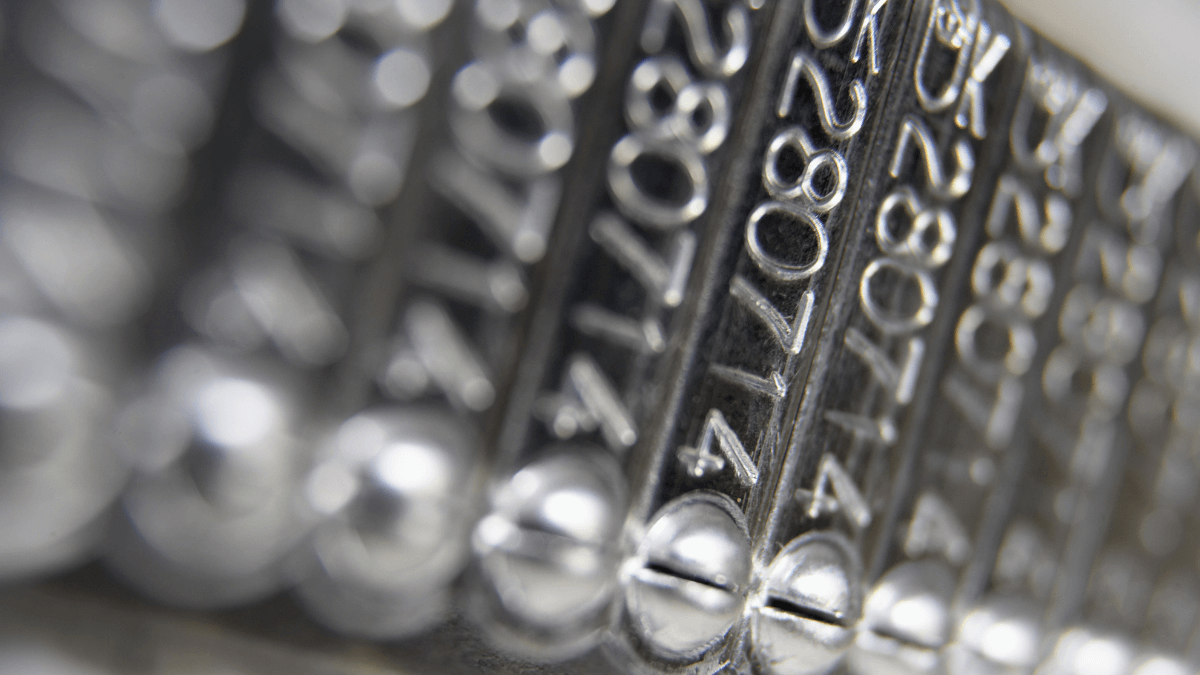Key Takeaways
- Not knowing what equipment you have, or its condition can lead to poor auction decisions.
- Failing to conduct market research before auctions can result in unpleasant surprises.
- Overlooking pre-auction inspections increases the risk of purchasing faulty or misrepresented equipment.
Both online and live auctions offer construction businesses great opportunities to acquire equipment at lower prices compared to traditional retail channels.
Moreover, the rising popularity of equipment auctions—particularly those conducted online—has been driven by many small to medium-sized contractors looking for more budget-conscious purchases.
However, new auction bidders often make mistakes that can turn what seems like a great deal into an unexpected financial burden.
In this article, we’ll explore these common pitfalls and offer practical tips on how you can avoid them.
In this article...
Not Having a Clear Inventory of the Equipment You Own
Before taking part in an equipment auction, whether online or live, one common mistake many contractors make is not knowing exactly what equipment they already have.
Without a clear and up-to-date inventory of their existing equipment, including its condition and availability, they risk:
- purchasing unnecessary items,
- overpaying for bought equipment, or
- overlooking crucial operational needs.
You might think that buying an expensive piece of equipment while unknowingly already owning one or several seems far-fetched for any construction company, but think twice.
For instance, many contractors buy equipment at the end of the fiscal year to reduce taxable income.
While this can be a smart financial move, it can also lead to unnecessary purchases or overspending on a new model simply because there’s extra money available.
As this Reddit user insightfully points out:

This comment highlights a mindset that leads some buyers to purchase equipment impulsively.
While chasing a maximum tax deduction, contractors may overlook the equipment they already own—especially if their inventory isn’t accurate and regularly updated.
For example, if your asset records incorrectly show that you don’t have a particular excavator model, you might place a bid for one at an auction.
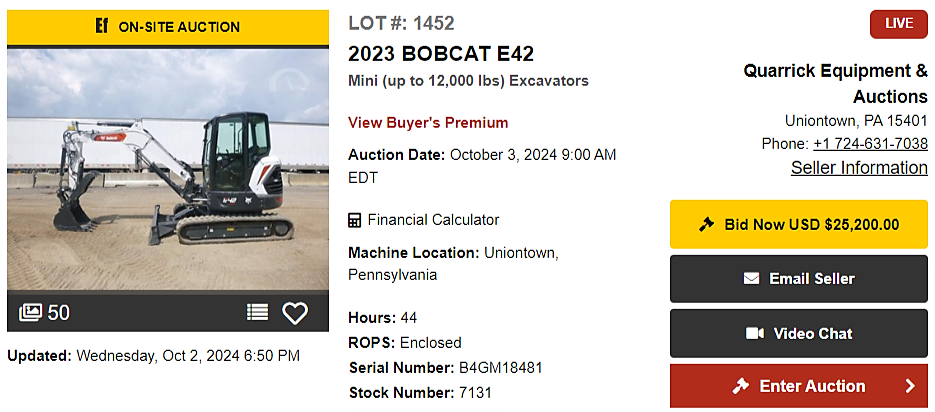
However, later you might end up realizing that a similar machine has been sitting unused in storage or at a former job site for months.
This simplified example demonstrates how failing to track your assets can lead to serious financial missteps, like buying redundant equipment.
To avoid this, you need to ensure that your inventory of equipment and tools is regularly updated and reviewed.
Spreadsheets are still commonly used, but they’re time-consuming and error-prone.
Conversely, a cloud-based, centralized digital inventory that can be easily accessed, updated, and reviewed on any internet-connected device is a much more practical option.
This is exactly what our asset tracking and management solution, GoCodes Asset Tracking, provides.
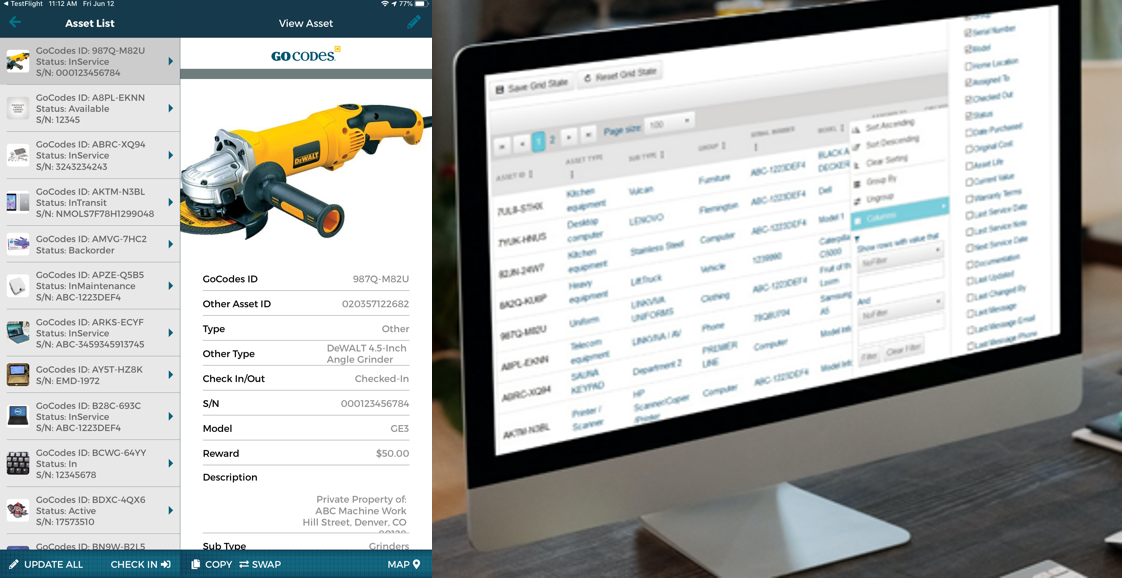
More specifically, a standard GoCodes Asset Tracking package includes:
- affordable and durable QR code tags that are attached to your equipment, and
- cloud-based software (and a mobile app) with a built-in scanner for smartphones and tablets.
You can see these components below.
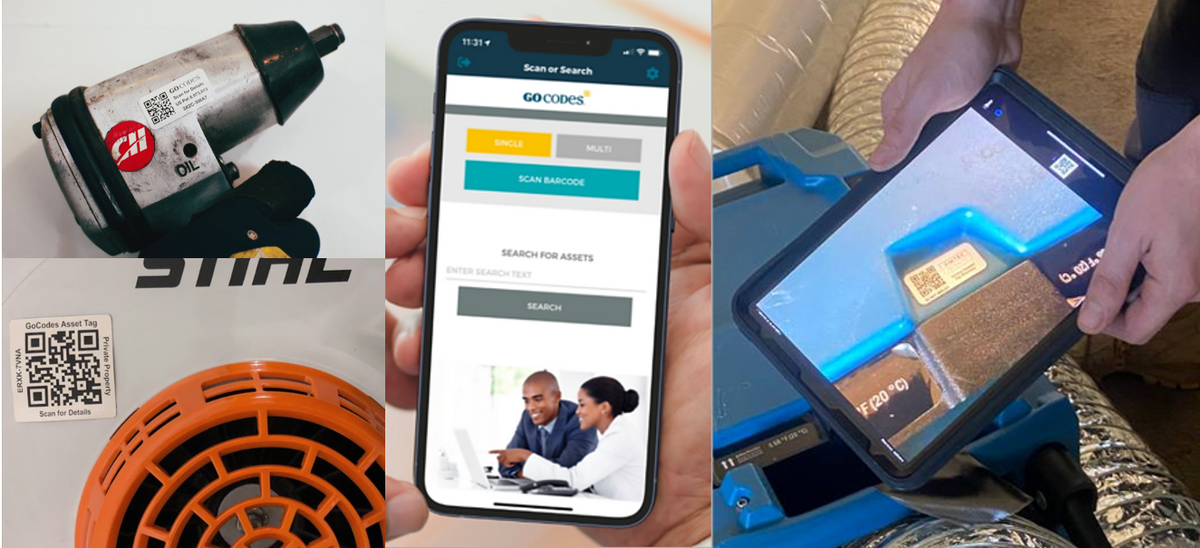
This simple, scan-based asset management system ensures that you, the equipment manager, and other employees can access, view, and—depending on user authorizations—update the central inventory of assets.
As the data fields in the central database are customizable, you can use them to record any number of critical equipment info, from its purchase date to check-in/out log, maintenance history, and service notes.
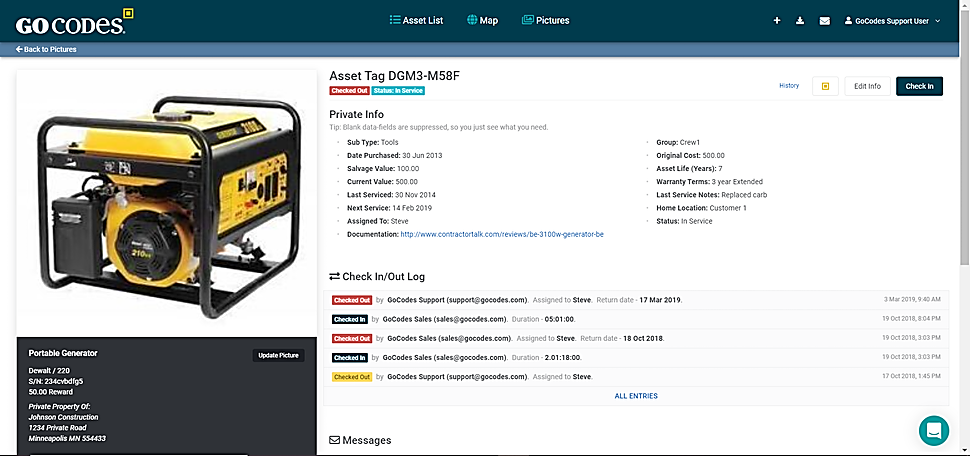
In short, this digital system enables you to get a clear, up-to-date inventory of equipment you own with a few screen taps or mouse clicks.
That way, you can review your equipment before planning any purchases at auctions, or even when just browsing online auctions and something catches your eye.
Overall, with a system like GoCodes Asset Tracking, you can determine the condition, usage, and depreciation rate of your equipment, thus enabling more informed, data-driven decision-making when placing your bids.
Ultimately, this ensures your purchases at any auction are strategic investments, rather than impulsive expenses.
Failing to Do Market Research
Similar to having an inaccurate or outdated inventory, not doing general market research on the construction equipment you want to bid on at an auction can lead to poor decisions.
More specifically, since both live and online auctions are time-limited and can move quickly, there may be moments that require quick judgment calls.
So, it’s critical to come prepared.
As we’ve just mentioned, it’s important to first determine exactly what type of equipment your business needs.

While the type you need is often—but not always—obvious, specific equipment makes and models and how they fare against your operational goals are not.
Therefore, engage your team and ask operators and other professionals for guidance.
Once you have a clear understanding of the equipment you need, research the market to determine
- its current value versus its age,
- variations in specifications and prices across models, and
- resale potential.
This involves comparing brands and models, reviewing performance ratings and user testimonials, and analyzing pricing and demand trends.
Doing this groundwork ahead of time should provide clear benchmarks to assess the condition of auctioned equipment against its price.
Ultimately, thorough market research before an auction will help you recognize when a piece of equipment is priced favorably and when it’s better to walk away.
This minimizes the chances you’ll overpay and informs you when there’s a good deal to be made and a higher bid is actually justified.
Not Inspecting the Equipment
Another common mistake many auction participants make is not inspecting the equipment thoroughly or skipping the opportunity to view it in person when that’s an option.
As you may know, equipment sold at auctions can vary in condition.
Despite this, auction organizers usually don’t conduct detailed inspections, leaving it up to the buyers to assess the equipment themselves.
As a result, equipment is typically sold as-is, and any defects or maintenance needs may not be disclosed.
Here’s how Integrity Sales & Auctions explain this:
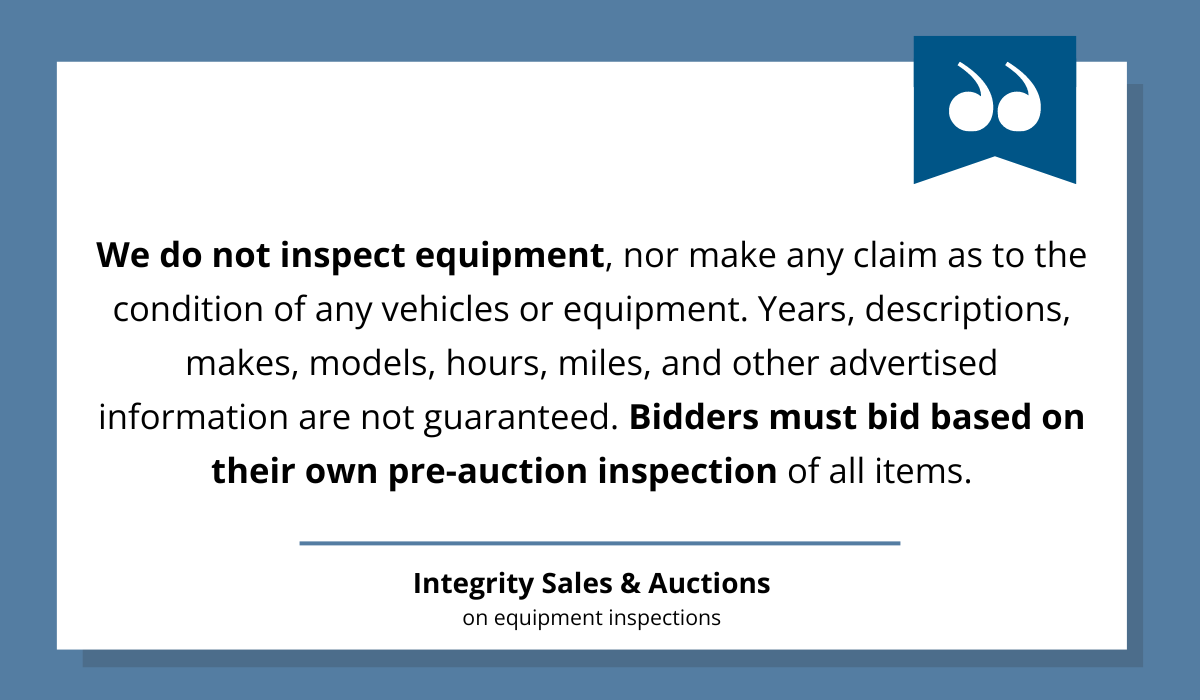
Given this, it’s critical to assess the equipment’s age, wear and tear, and maintenance history to avoid purchasing something that may soon require costly repairs.
Therefore, if you’re attending a live auction, make sure to participate in its inspection days.
This will allow you to inspect the machine in person, do a walkaround, and examine it for issues like:
| Potential issue | What to inspect |
|---|---|
| Wear or damage | Check critical components like hydraulic lines, belts, or hoses for any signs of visible wear or damage |
| Rust | Inspect for rust, especially on the undercarriage or any key structural components that could affect durability |
| Leaks and fluid levels | Look for leaks or signs of leakage and ensure fluid levels are consistent and within normal ranges |
| Recent repairs | Examine for signs of recent repairs, including welding, especially in areas not disclosed by the seller |
| Operator controls | Check whether controls in the operator’s area are functioning properly |
Of course, this list could be longer and more detailed, so it’s best to have an inspection checklist ready.
However, it’s worth noting that there are some online auction services that put a lot of effort into conducting equipment inspections.
Bidadoo is one such example.
The company’s President, Howard Hawk, explains that bidadoo prides itself on providing more equipment details than traditional live auction models, allowing potential buyers to bid with confidence.
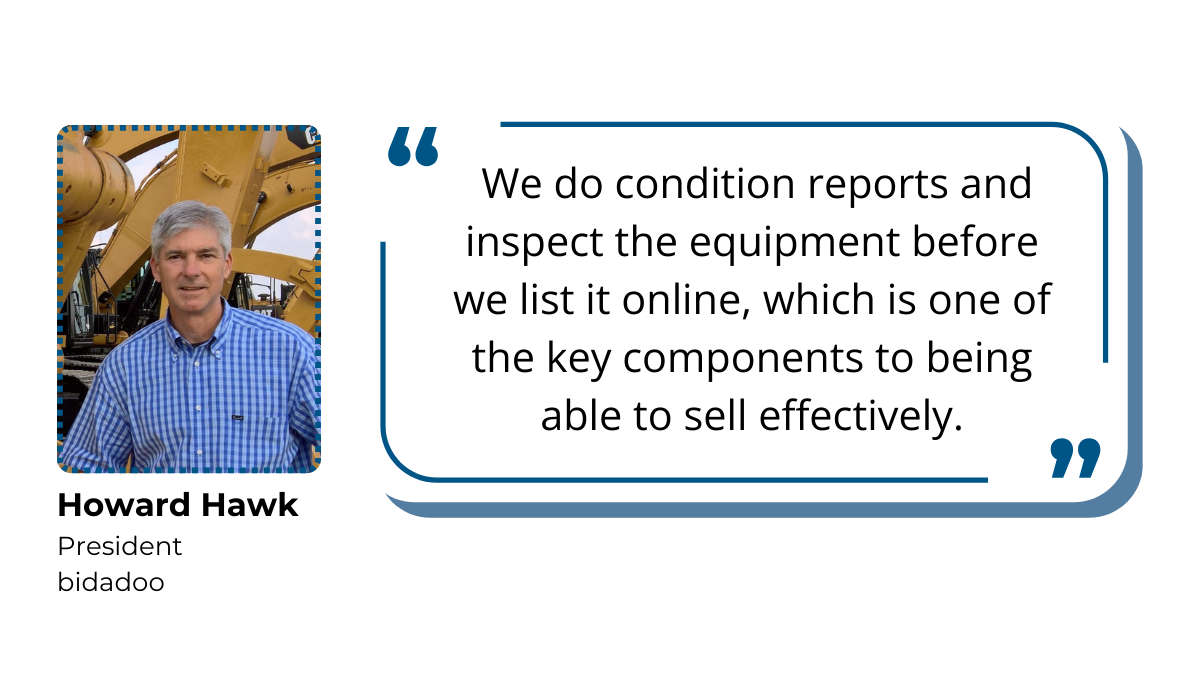
And while test driving the equipment is not always possible, ensuring that the machine starts properly and runs smoothly is.
But how do you check for these and other issues in online auctions?
By investing time in carefully reviewing the photos, videos, and documentation provided by the seller and potentially contacting them for clarifications.
Alternatively, for both live and online auctions, you can hire a professional third party to inspect the equipment on your behalf.
Here’s an example of a company that offers such services.
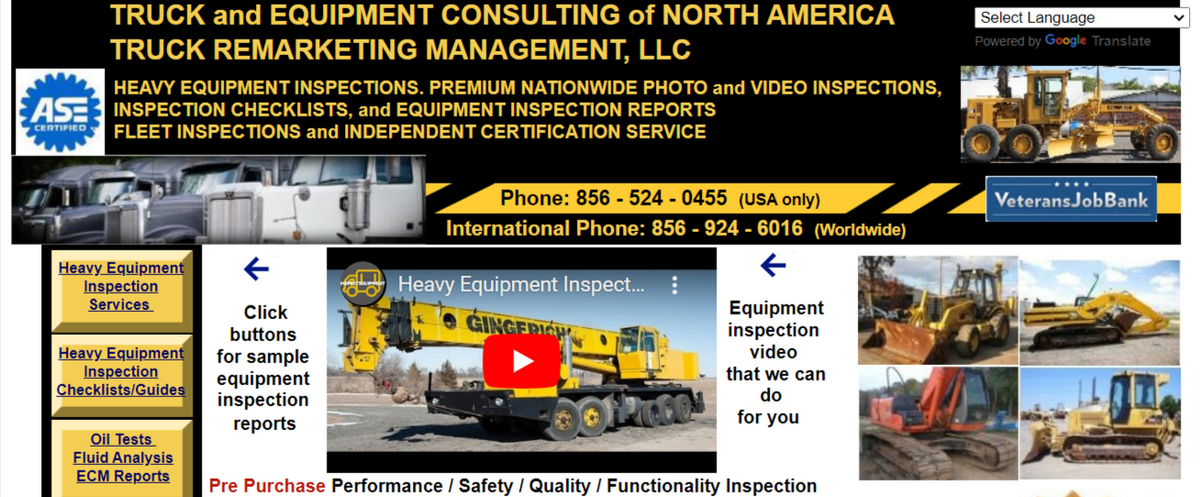
As shown, this company (and others like it) will provide you with a detailed equipment inspection report, including photos and videos.
Overall, such inspection services can be invaluable, especially when you can’t attend an auction in person or lack the expertise to thoroughly evaluate the equipment yourself.
The bottom line is, whether you inspect the equipment yourself or hire a professional, doing so minimizes the risk of ending up with faulty or misrepresented assets.
This allows you to place your bids with more confidence, ultimately protecting your investment and ensuring the equipment meets your operational needs.
Failing to Account for Additional Fees
Sometimes, buyers—especially inexperienced ones—may not be aware of additional fees that come with auction purchases.
These include the buyer’s premium, state sales and use taxes, as well as transportation costs.
Even seasoned buyers can overlook these costs when hunting for great deals.
Since we’ll cover the issue of transportation costs in more detail later on, let’s focus on the buyer’s premium and taxes.
The buyer’s premium is a fee that auction organizers charge you if your bid wins the auction.
It may either be a flat fee or, more commonly, a percentage of the hammer price.
This percentage typically ranges from 10% to 20%, though it may be lower for smaller amounts or capped (flat fee) for larger ones.
Most auctioneers will either list the premium’s percentage or provide a link where you can see it and calculate the premium by entering the “sold” price.
You can see what that can look like in practice in the image below.
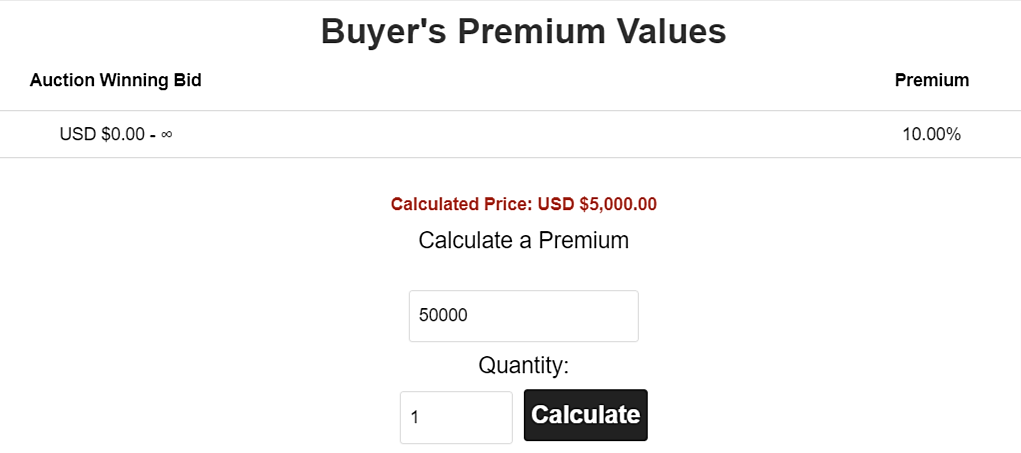
As shown, the premium in this case is 10%.
If your winning bid is $50,000, you would pay an additional $5,000 on top of that amount.
So, be sure to check the buyer’s premium with your auction house, as well as any additional fees they may charge.
When it comes to taxes, the situation is much less straightforward.
More precisely, the sales tax rate, use tax rate, and any additional locality-specific taxes applicable to your transaction depend on various factors, including your location and the nature of your purchase.
To illustrate this complexity, consider the sales tax explanation from IronPlanet, an online auctioneer:
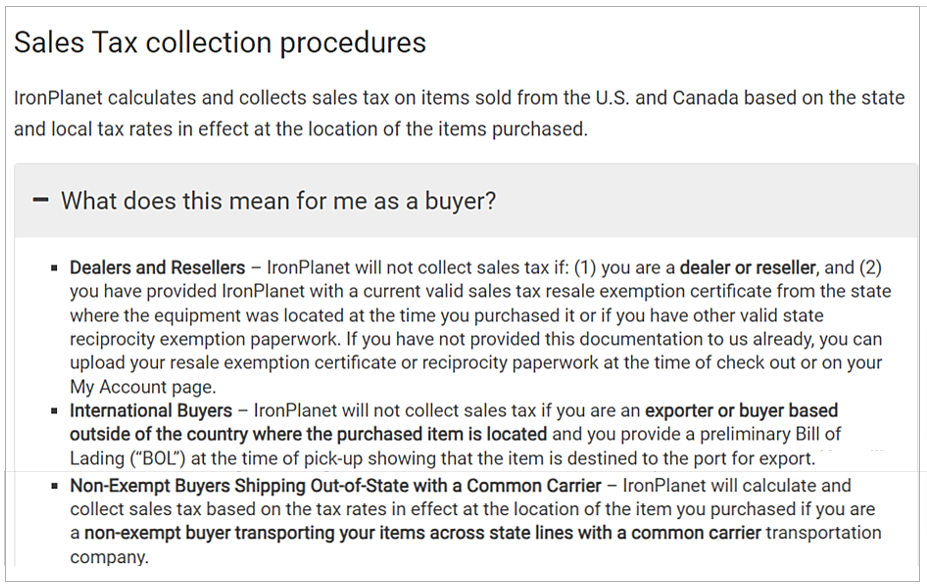
Keep in mind that this policy refers only to sales tax on equipment sold in the US and Canada.
This means it doesn’t account for other taxes or fees that might apply, such as import duties or local levies in different regions.
To avoid surprises, always check with the auction house for specific tax information based on the location of the item and your own circumstances.
This may involve providing exemption certificates if you qualify or factoring in state and local tax rates for non-exempt buyers.
With the buyer’s premium and taxes accounted for, it’s also important to consider transportation costs, which brings us to the last mistake on our list today.
Forgetting About Transportation Costs
Moving heavy equipment can be expensive, that much is certain.
So, failing to factor in these costs could eat into the savings you expected from getting a good deal at the auction.
Therefore, you should always consider how much it will cost to get the equipment from the auction site to your location.
Once a buyer wins an auction, they are typically responsible for picking up the equipment from the auction house within a specified removal window.
This is because most auction houses don’t offer shipping services, although there are exceptions.
For example, Richie Bros. provides global equipment shipping and transport services, allowing you to conveniently arrange transportation at an additional cost.

While such services are convenient, they can be costly.
In most cases, however, you’ll need to arrange transportation on your own.
If the equipment is on wheels and drivable, that’s no problem.
However, even in such cases, there are costs to consider, such as fuel, insurance, and potential fees for temporary tags.
When equipment is on crawlers or otherwise not drivable, transporting it will typically require specialized knowledge, proper licensing, and experience.
In these cases, it’s best to turn to professional carriers and gather quotes, like in the example below.

Keep in mind that the transportation costs may also include:
- additional permits and fees for transport across state lines,
- insurance for the transport, if not covered by the carrier,
- loading and unloading fees, if charged by the carrier.
A user on Heavy Equipment Forums brings up just that:
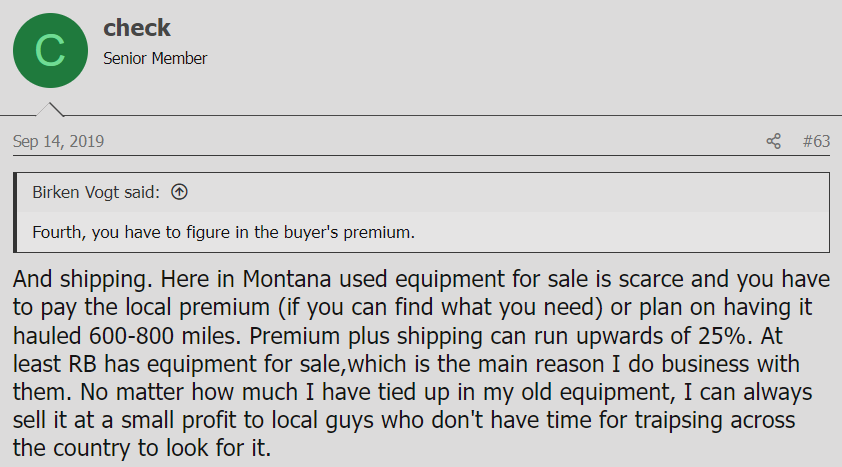
Overall, accounting for transportation costs upfront helps ensure you avoid surprises that could reduce the savings from your auction purchase.
Conclusion
So, we’ve covered what mistakes need to be avoided to ensure your auction endeavors result in purchasing quality assets at a competitive price.
By doing your due diligence—from having a clear inventory to researching fees and tax obligations, inspecting equipment, and budgeting for transportation—you can make informed, data-driven bids.
Keep these considerations in mind, and you’ll be well-equipped to make smart, cost-effective decisions at your next auction.
Good luck!





